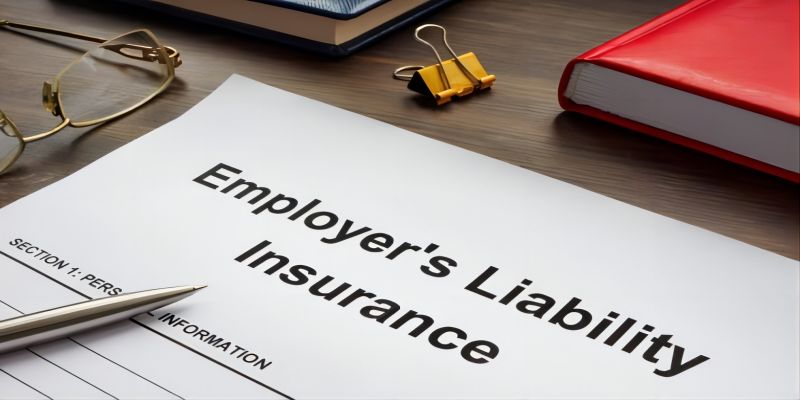Employer's Liability Insurance is a crucial protection for businesses, providing a safeguard against potential claims arising from employee injuries or illnesses that occur as a result of their work. This comprehensive guide is designed to demystify this essential coverage, elucidating its functionalities, benefits, and the circumstances under which it is required. Whether you're a fledgling business owner seeking clarity on your legal responsibilities, or an established company aiming to ensure full compliance and adequate protection, this guide will serve as an invaluable resource. From understanding the basics to navigating the complexities of premiums and claims, we'll walk you through every facet of Employer's Liability Insurance to help you protect both your business and your valued team members.
Defining Employer’s Liability Insurance

Employer's Liability Insurance, also known as Workers' Compensation Insurance, is a form of coverage that safeguards businesses against legal and financial liabilities resulting from employee injuries or illnesses sustained in the workplace. In essence, this insurance protects both employers and employees by providing compensation for medical expenses, lost wages, and other associated costs in the event of an employee's work-related injury or illness. It is typically required for businesses with employees, and failure to secure this coverage may result in significant penalties and legal consequences.
Who Needs Employer’s Liability Insurance?
Employer's Liability Insurance is a legal requirement for most businesses with employees. In general, if you have employees working under a contract of service or apprenticeship, then you are likely required to have this coverage. This includes full-time, part-time, and temporary workers, as well as volunteers and subcontractors in some cases. However, the specific requirements may vary depending on your business structure, location, and the nature of your employees' work. It's crucial to consult with a reputable insurance provider or legal expert to determine your specific obligations.
What Does Employer’s Liability Insurance Cover?
Employer's Liability Insurance covers a broad range of work-related injuries and illnesses, including but not limited to accidents on the job, occupational diseases, and repetitive strain injuries. It typically provides coverage for medical expenses, lost wages, disability benefits, rehabilitation costs, and death benefits in the event of a fatal injury or illness. It may also cover legal fees and settlements if an employee files a lawsuit against your business.
Benefits of having Employer's Liability Insurance
- Compliance with Legal Requirements: Most businesses are legally required to have Employer's Liability Insurance for their employees. Having this coverage ensures that you are in compliance with the law and avoids potential penalties or legal consequences.
- Protection for Your Business Assets: Workplace injuries or illnesses can result in significant financial losses for a business, including medical expenses, lost productivity, and legal fees. Employer's Liability Insurance provides a safety net to protect your business assets from such expenses and minimize financial strain.
- Care and Support for Your Employees: As an employer, it is your responsibility to provide a safe work environment for your employees. In the unfortunate event of a work-related injury or illness, having Employer's Liability Insurance shows that you care about your employees' well-being and are willing to provide the necessary support.
- Peace of Mind: Running a business comes with its fair share of risks and uncertainties, but having Employer's Liability Insurance can bring peace of mind knowing that you have protection in place for potential workplace incidents.
Navigating Premiums and Claims
The cost of Employer's Liability Insurance premiums varies depending on factors such as the size of your business, industry type, and claims history. It's essential to shop around and compare quotes from different insurance providers to find the best coverage at a competitive price. When it comes to filing a claim, it's crucial to follow the proper procedures outlined by your insurance provider and provide all necessary documentation and evidence. Working with an experienced insurance agent can also help streamline the claims process and ensure a favorable outcome.
How to Get Employer's Liability Insurance?

Getting Employer's Liability Insurance involves a series of steps to ensure that you secure the right coverage for your business. Here's a step-by-step guide:
- Assess Your Business Needs: Understand the specific risks associated with your industry and the nature of your employees' work. This will help you determine the level of coverage you need.
- Consult a Legal Expert or Insurance Advisor: Professional advice can be invaluable in navigating insurance complexities, ensuring compliance with legal requirements, and understanding the specific needs of your business.
- Research Insurance Providers: Look for reputable providers that specialize in Employer's Liability Insurance. Consider their offerings, customer service reputation, and claim handling process.
- Gather Necessary Information: Before applying, prepare essential information about your business such as number of employees, nature of their work, previous insurance claims, and safety measures in place.
- Request Quotes: Contact selected insurance providers to request quotes. Ensure you understand what each quote covers and any additional costs that may apply.
- Compare Quotes: Analyze quotes from different providers, taking into account not just the cost but also the extent of coverage, terms and conditions, and any exclusions.
- Apply for Coverage: Once you've chosen a provider, complete the application process. This may involve filling out forms with details about your business and your chosen coverage.
- Review Policy Documents: Upon receipt of your policy documents, review them carefully. Ensure they accurately reflect your chosen coverage and understand all terms and conditions.
- Pay Your Premium: Once you're satisfied with the policy terms, pay your first premium to activate your coverage.
- Maintain your Policy: Regularly review your policy to ensure it remains suitable for your business needs, especially if there are significant changes in your operations or staff.
This process may vary depending on your location and the specific provider, but these steps provide a general overview of what to expect when applying for Employer's Liability Insurance.
Conclusion
Employer's Liability Insurance is a critical component of any business' risk management strategy. It protects both your business and employees from financial losses in the event of work-related injuries or illnesses. As an employer, it's essential to understand your legal obligations and ensure that you have the necessary coverage in place. By following the steps outlined above, you can secure suitable coverage for your business and have peace of mind knowing that you are prepared for any potential workplace incidents. So, it is advisable to research and consult with insurance experts before making a final decision on your coverage to ensure that your specific needs are met.







